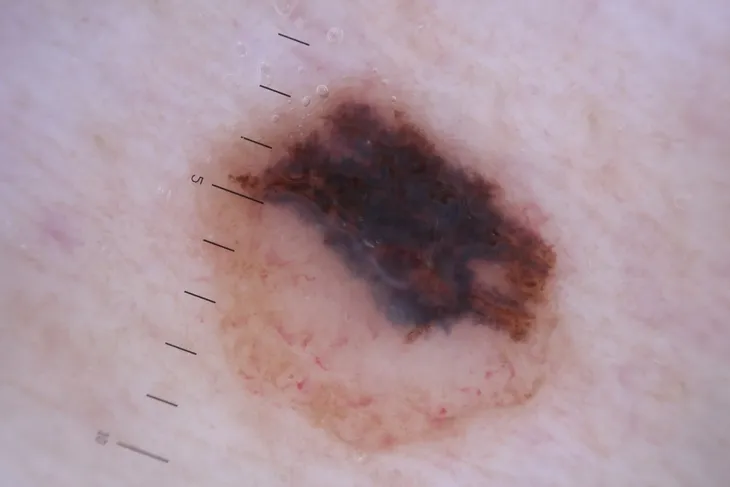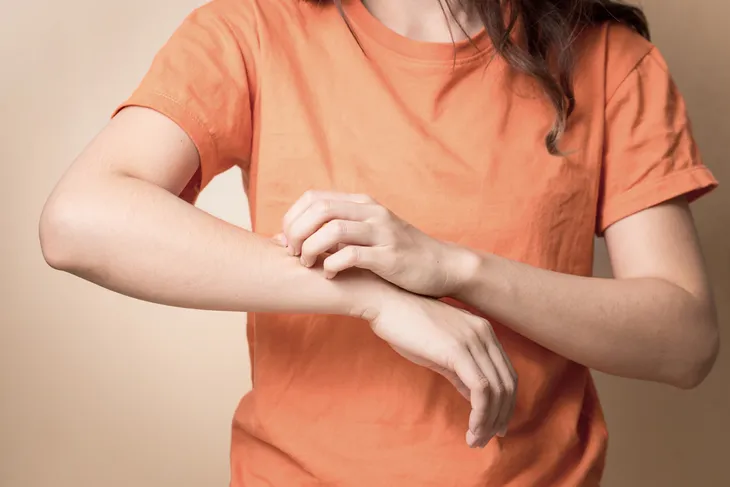Being careful and cautious with our skin is something that was ingrained in us from childhood. We’re constantly being warned about the dangers of the sun and how to protect it from sunburns, sun damage, and even aging. Bottom line, wearing sunscreen is important. The biggest reason is because it protects us from skin cancer.
You might think skin cancer is the one cancer that is the easiest to spot, because it can be seen from the outside of our body, which is not always the case! Thankfully, we’re able to do routine checks of our skin, which means we’ve got a better chance of catching it early. Experts recommend doing a thorough check of your skin every three months.
So, what are we looking for when it comes to cancerous moles? Not sure? What are the main signs to look for when it comes to spotting and detecting cancerous moles? Don’t worry, we’ve got you covered. Here’s a detailed list of the most common warning signs…
Asymmetry
The golden rule for checking cancerous moles is to follow the “ABCDE” technique. The first letter “A” stands for asymmetry. Healthy moles are usually symmetrical, which means they are equally sized (or both sides would match if folded in half). If you find a mole that’s uneven and one half of it doesn’t look like the other, you may want to get it looked at by your doctor or a dermatologist (a specialist in the study of skin).
Cosmopolitan recommends placing a mirror in the middle of the mole to see if both sides look the same. It’s important to note that all moles will be slightly irregular, and none of them will be exactly perfect in shape. Use your best judgement. Keep checking it, and if it’s clearly asymmetrical, seek out a medical opinion.
Blurred Border
The second letter “B” stands for border. Healthy moles typically have a defined border. However, melanomas (or cancerous moles) tend to appear blurred or irregular around the outside edges. They can also feel raised to the touch with ragged, scalloped edges.
Color Changes
The third letter “C” stands for color. The first sign of a potentially cancerous mole is a drastic change in color. For instance, moles that are dark, brown, grey, or inconsistent in color (i.e., black in the middle and tan, white, red, or pink around the outside). If this is the case, you should bring it to your doctor’s attention.
Cosmopolitan informs readers that the color of your skin will determine the color of your moles, so you can’t necessarily compare your moles to those of someone else. It’s whatever is normal for you. “If all of your moles are similar then that is a good sign. Also, there is a lesion called simple lentigo, also known as an ink spot, which are extremely black but benign (not cancerous). It’s always safe to have these lesions assessed due to the dark pigment,” writes the source.
It is also possible for moles to change over the span of our life. One that is light when you were a young child might become darker later in your life. The biggest indication that a mole is cancerous, when it comes to color, is if it changes drastically in a short period of time or if it has multiple colors within it. You should also compare it to other moles on your body and see if it sticks out from the others.
Diameter
The fourth letter “D” stands for diameter. Healthy moles don’t grow any larger in size than 6-millimeters (or a ¼ inch) in width. If you have a mole that’s large or gradually growing in size, book a medical exam to determine if it’s cancerous.
Of course, there is an exception. Congenital moles, which may be referred to as a birthmark, tend to be large but benign. These are present from birth and will not change. Because they are dark in color, they can be at risk for melanoma. The best way to tell if a large mole is cancerous is to watch if it is slowly growing in size (or has grown) and is changing (or evolving).
Evolving Moles
The last letter “E” stands for evolving. Moles that develop new symptoms such as bleeding, itching, or crusting should be considered suspicious for skin cancer. In addition, a mole that has inconsistencies—for example, it transitions in color, shape, height, or surface texture—might be dangerous or unhealthy and should be inspected by a medical professional.
Itchy and Sore
Any mole that causes pain or is tender to the touch should be considered dangerous, particularly if the mole exudes fluid or blood. “Large intradermal moles may catch on items of clothing, which can cause them to be itchy or sore,” writes Cosmopolitan. If this is the case, visit your doctor immediately for a skin exam.
Sores That Don’t Heal
A new mole or a sore that won’t heal no matter how much time, air, cleaning, and ointment you apply may be a potential skin cancer risk. You should also pay particular attention to the texture of this sore or mole. Is it lumpy, rough, dry or scaly on the surface? What about itchy or tender to the touch? Any mole that refuses to heal, bleeds or develops a crusty scab needs attention immediately.
Raised Mole
We talked about moles that are large, evolving in shape, or have irregular borders. But another sign to watch for that isn’t apart of the “ABCDE” technique is to check if the mole is raised. According to Cosmopolitan who talked to Claire Crilly, Skin Cancer Screening Specialist at The MOLE Clinic, raised moles can be “a healthy benign intradermal mole, which can be genetic, long standing, soft, and sometimes wobbly to touch.” They can also change in color and get darker with age. While these moles aren’t usually all that concerning, they should always be monitored closely.
If a mole that wasn’t raised before now becomes raised it may need additional evaluation by your dermatologist. Your moles can change overtime, and that includes being raised. However changes like this along with other signs listed above would be more concerning. If any of your moles change in shape, color, or form, they should be checked by a dermatologist.
Dysplastic Moles
Individuals with dysplastic moles, which refers to moles greater than 6-millimeters in diameter with dark centers and blurred edges, almost double your risk of developing melanoma (the most dangerous of skin cancers).
“Ugly Ducklings”
Another great technique that can sometimes help when checking for cancerous moles is to look for any “ugly ducklings,” says Everyday Health. You should ask yourself, does it look any different than the other moles around it? “It might be larger and darker, for instance, or it might be a small red mole surrounded by bigger brown moles,” writes the source. “For a person who has few other moles, any change in a spot or growth makes it an ugly duckling.”
A study performed by the Mayo Clinic in Arizona found that checking for “ugly ducklings” was actually easier for patients than the “ABCDE” technique.
Other Concerning Signs
WebMD warns that any new mole should raise a bit of suspicion and should be checked out by a dermatologist, as they can examine it and do a skin biopsy, if necessary. You should also keep in mind that not all cancerous moles will fit into the above characteristics.
The source also states that, for men, the most common place for melanoma is in the back, while for women, it’s on the lower legs.
Family History
Unfortunately, many of our health issues are passed down by family members. In the case of skin cancer or a lot of suspicious moles, a history of the disease can put you at an increased risk. So, if you have a first-degree relative (i.e., parents or siblings) with a skin cancer, you may be at increased risk for developing skin cancer, which makes the “ABCDE” technique and sunscreen even more important.
Tips for Skin Cancer Screening
When it comes to checking for skin cancer, in addition to looking for all the above warning signs we just discussed, WebMD suggests keeping track of all your moles. The best way to do this is with photos. Mark the photos with a date so you know how fast they are growing and changing, if at all. “If they do change in any way (in color, shape, size, border, etc.) or exhibit other ‘ABCDE’ features, see your doctor,” writes the source.
Obviously, there are parts of our body that we cannot see. Unfortunately, they still need to be checked! Consider investing in a full-length mirror. You could also have a partner, close family member, or even a friend help out. When you’re doing a full body check, start with the head (including the scalp) and work your way down looking at each and every single body part, front and back. You even need to check fingernails and toenails! “Also be sure to check the ‘hidden’ areas: between your fingers and toes, the groin, the soles of your feet, and the backs of your knees,” says WebMD.
















